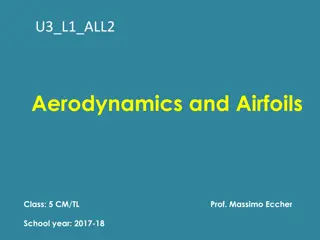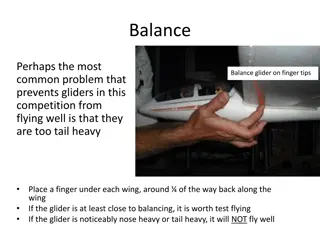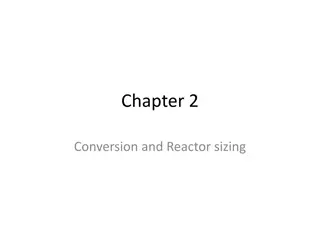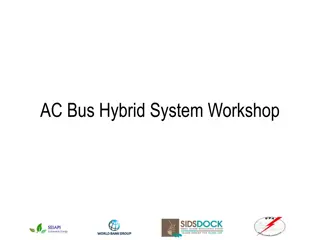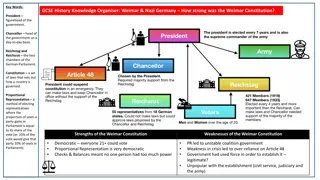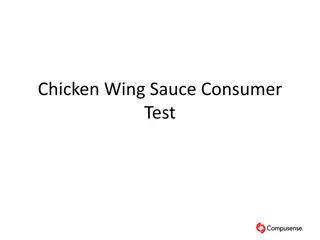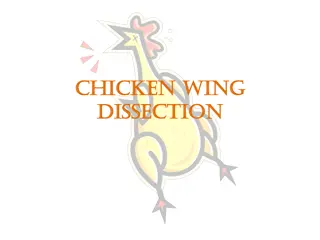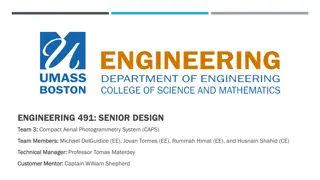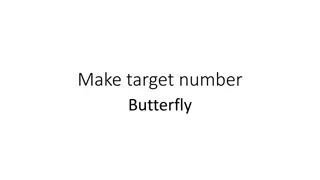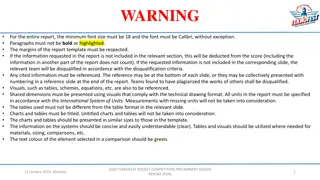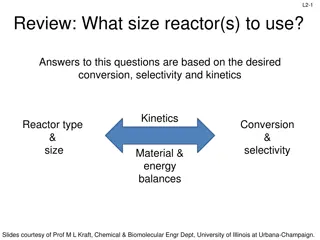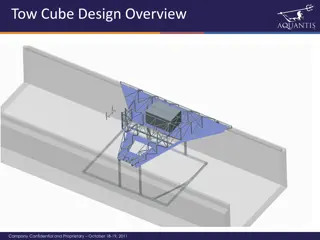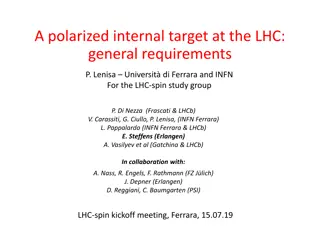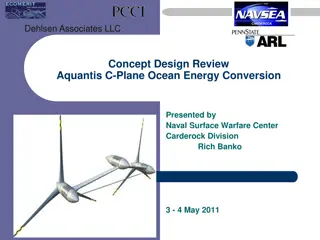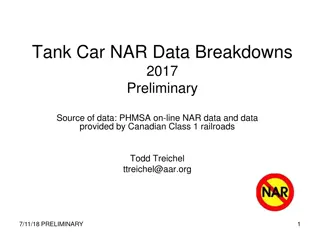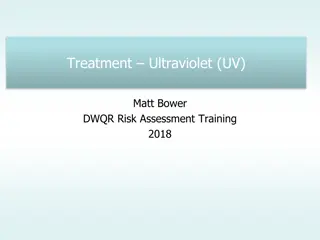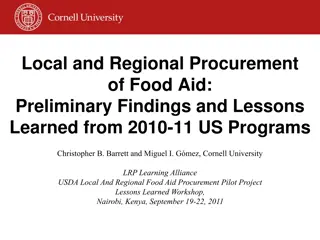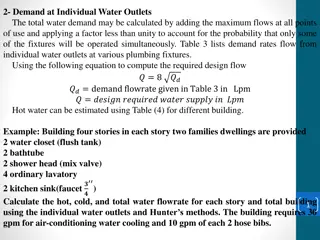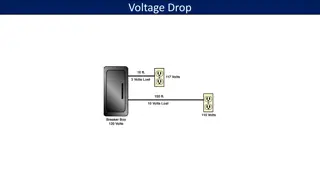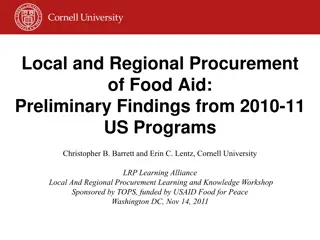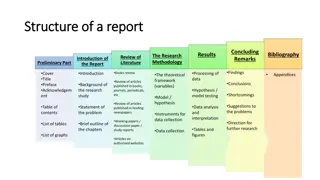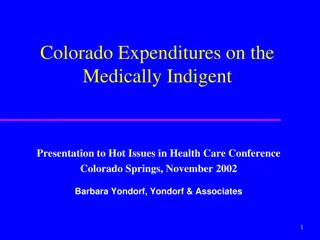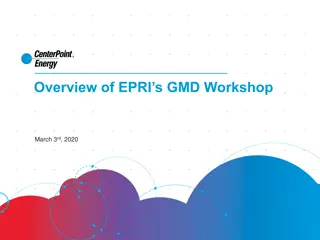Preliminary Wing Sizing and Design Process Overview
Explore the preliminary design process for wing sizing in aircraft engineering, including key topics, weight estimation spreadsheets, configuration layouts, propulsion system options, and structural considerations. Dive into sensitivity studies, takeoff thrust, aspect ratios, payloads, and more to refine the design for optimal performance and efficiency.
Download Presentation

Please find below an Image/Link to download the presentation.
The content on the website is provided AS IS for your information and personal use only. It may not be sold, licensed, or shared on other websites without obtaining consent from the author. Download presentation by click this link. If you encounter any issues during the download, it is possible that the publisher has removed the file from their server.
E N D
Presentation Transcript
Preliminary Wing Sizing G. Marien AE460 Lecturer
Topics Design Process Refresher Design Mission/OV-1 Diagram Preliminary Weight Estimate (spreadsheet) Preliminary Wing Sizing 2
Preliminary Design Process (Roskam) Statement of Work System Requirements Document Part I Preliminary Sizing Sensitivity Studies Used for Refinement of Preliminary Sizing MGTOW or TOGW (WTO) Takeoff Thrust (TTO) Wing Planform Area (S) Aspect Ratio (AR or A) Empty Weight (WE) Fuel Weight (WF) Payload Weight (WPL) CLmax (clean, TO/L) Part II Configuration Layout and Propulsion System Options Initial Layout of Wing and Fuselage Tail Sizing Weight and Balance Drag Polar Landing Gear Configuration Candidates Identified for Further Study Layout of Wing, Fuselage and Empennage Weight and Balance Drag Polars Flap Effects Stability and Control Performance Structural Layout Landing Gear Life Cycle Costs Refinement Sizing Iteration and Reconfiguration Other Design Activities Flight Loads Structural sizing Preliminary Configuration Design Complete
OV-1 : RCR 1.1.2 Present an OV-1 diagram with key requirements, design missions and design features of the aircraft that meet the requirements. Print on a single 11x17 sheet. You may use 2 sheets if needed to convey your message 4
Weight Estimate Spreadsheet Weight Estimate based on: Takeoff weight guess Design mission profile/payloads Estimated fuel fractions from similar aircraft WTO-Guess (lbs) 5000 Guess-Max Takeoff Gross Weight Max Takeoff Gross Weight airplane operating weight empty mission fuel weight payload weight 200 PL1 300 PL2 595 PL3 R: Ch2, Pg 7, Step 2 WTO (lbs) WOE (lbs) WF (lbs) WPL (lbs) 5698 3725 878 1095 R: Ch2, Pg 7, Step 1 2 racks @ 100 lbs ea 6 @ 25 lb each practice bombs GPU-2/A 20 mm pod WOE-tent (lbs) WE-tent (lbs) 3027 WOE (lbs) 2602 3725 airplane operating weight empty 3300 Empty Weight WME (lbs) WFEQ (lbf) R: Ch2, Pg 7, Step 4 R: Ch2, Pg 7, Step 5, 6 R: Ch2, Pg 47, Table 2.15 WE (lbs) WE, calc 3263 2963 Change WME A 0.6632 B 3000 Manufactures Empty Weight 300 Fixed Equipment Weight 300 Avioincs Weight 0.864 4 ft3 AirConditioning Special Radar APU Furnishings and interiors Other equipment needed WTFO (lbs) WCREW (lbs) 25 trapped fuel/oil 400 Crew Weight 200, each pilot 0.005 percent WTO Mission Fuel Weight, P1, Sec 2.4 R: Ch2, Pg 7, Step 3 Note: these weight values can feed back into the design mission segment values (temporary). WF (lbs) 878 mission fuel weight 770 Fuel used for mission 108 Fuel Reserves WFused (lbs) WFres (lbs) Segment End Weight (lbs) Segment 1 2 3 WTO 5000 4950 4901 4851 Speed KTAS Distance NM Engine S/U and W/U Taxi Takeoff W1/WTO W2/W1 W3/W2 0.990 W1 0.990 W2 0.990 W3 4 Climb Ecl (nm) cj (lbm/(lbf*hr)) L/D W3/W4 0.2 hrs 0.9 specifc fuel consumption 9 1.0202 W4/W3 0.980 W4 12 minutes to 30000 ft 300 60 5 4755 From Breguet's Equations
Sizing Calculated Guess Requirements come from: SRD (customer requirements) 14CFR23 14CFR25 MIL-C-005011 Takeoff Sizing - Example Roskam I, 3.2.5, p101 Takeoff? Sizing 2500 Per SRD, 3.10.5 0.025 Roskam I Table 3.2 0 SLS per MIL-C-005011 1.8 F91 Specification 0.019 Assumed value, to be refined 0.002377 Air density @ SL, Nicolai Table B.1 p682 0.0447 Roskam I, p102 0.879 Roskam I, p102 STOG (ft) G Friction Coeff. Altitude (ft) Bypass Ratio CDo r (slugs/ft k1 k2 Takeoff Landing 3) Cruise Roskam I Eq 3.9, p102 (rearranged) CLMAXTO 1.2 (W/S)TO (psf)(T/W)TO 40 60 80 100 120 1.6 2.0 2.4 2.8 3.2 0.31 0.45 0.60 0.74 0.88 0.24 0.35 0.46 0.56 0.67 0.20 0.28 0.37 0.46 0.54 0.17 0.24 0.31 0.38 0.46 0.15 0.21 0.27 0.33 0.39 0.13 0.19 0.24 0.30 0.35 Climb Including OEI Time to Climb Use an input W/S (wing loading) to obtain a T/W (thrust to weight) Requires a lot of estimating or Rate of Climb Maneuvering 7
Wing Size Matching MATCHING? RESULTS? FOR? SIZING? OF? CAS W/STO (takeoff wing loading) = XX psf T/WTO (takeoff thrust to weight) = XX psf 1.20 CLMAXL1.2 CLMAXL1.6 1.00 SUSTAINED? TURN TAKE-OFF? THRUST-TO-WEIGHT? RATIO? (T/W)TO TO? CLMAX? 1.2 CLIMB-STORES TO? CLMAX? 1.6 0.80 TO? CLMAX? 2.0 CLIMB-CLEAN TO? CLMAX? 2.4 L? CLMAX? 1.2 CRUISE 0.60 L? CLMAX? 1.6 CRUISE OEI?- TO,? GU,? 95F,? SL Climb? - Clean 0.40 Climb? - Stores OEI? CLIMB Sustained? Turn? (5g,? 500kts,? 20K) 0.20 0.00 0 10 20 30 40 50 60 70 80 90 100 110 120 130 TAKE-OFF? WING? LOADING? (W/S)TO(psf) 8



